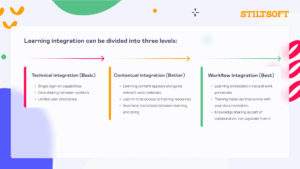Why LMS Features in Confluence Don’t Matter (Integration Does)

The Learning Management System (alternatively LMS) market tells a fascinating story. Companies are investing more in training technology than ever before.
Yet, training completion rates remain stubbornly low, knowledge retention is poor, and employees consistently report frustration with corporate learning.

What’s going wrong?
Most organizations (especially within Confluence) are asking the wrong question. Instead of “What features should our LMS have?” the question should be “How do we make learning feel seamless?” The answer isn’t in better LMS features in Confluence—it’s in better LMS integration in Confluence and learning tools interoperability, especially in Confluence collaboration tools.
LMS vendor promise vs. reality
According to Talent LMS and SHRM 2022 research, two-thirds of workers were dissatisfied with the training provided by their company. The main issue was the irrelevancy of the topics. Many courses employees had to take weren’t relevant enough. The graph below shows the soft skill training workers received and the training they would actually like to go through.

What are the usual promises of LMS vendors?
- Advanced analytics and reporting
- SCORM compliance and content libraries
- AI-powered personalization
- Mobile-responsive design
- and many more
Potential customers are intrigued by the number of features they will receive because, as we all know, the more, the better. They install the app or become subscribers, then begin the onboarding, and surprise-surprise — the amount of functionality in the product is overwhelming. Instead of building content for training, the L&D managers have to spend days understanding how the product works. And that’s just one of the potential drawbacks.
A well-known research analyst Josh Bersin wrote in his article about the learning industry:
As an analyst I actually found the last few years kind of dull, to be honest. We have helped hundreds of companies figure out what L&D systems to buy, but in most cases we found organizations with too many platforms, a mess of content all over the place, a lack of consistent data, and exorbitant over-spending in the domain. So this static period, which characterizes the last 3-5 years, was a good time for companies to “clean up” all their purchases in the last decade.
Often, the LMS is a standalone solution that is separate from other platforms employees are used to. So it just adds on as another tool to remember to log into, another tab in the browser, another reason to context-switch.
By the way, did you know it takes 23 minutes on average to regain focus after context-switching or about 9.5 minutes on average to return to a productive workflow after jumping from one digital tool to another?
The fundamental issue isn’t that LMS platforms lack features—it’s the juggling between all the platforms, including collaboration tools, that are required to complete the work.
What “better LMS integration” actually means
Most companies think integration means technical compatibility—can System A talk to System B? But true integration, involving learning tools interoperability and Confluence collaboration tools, is about workflow harmony: making learning feel like a natural part of work rather than an interruption to it. Therefore, LMS integration in Confluence is essential for seamless employee experiences.
Learning integration can be divided into three levels:
- Technical integration
- Contextual integration
- Workflow integration
Let’s discuss each of those in more detail.
1. Technical integration (Basic)
In education, technological integration is the use of technology to deepen learning and achieve pedagogical goals. Teachers can incorporate computers, smartphones, virtual reality tools, and other innovative devices to help students learn. Essentially, technical integration is the basis of e-learning, and no modern company can provide training without it. In turn, technical integration has its own four levels — SAMR (stands for substitution, augmentation, modification, and redefinition). But we will dive deeper into that another time.
Some of the examples of technical integration include:
- Single sign-on capabilities
- Data sharing between systems
- Unified user directories
2. Contextual integration (Better)
Contextual learning integration is presenting information in the right context and in a way that suits the learner to improve the learning process. It enables the learner to draw from the context of the information they receive. When content meets context, learning shifts from theoretical to practical, giving employees clear direction and connecting naturally to their current knowledge base.
The examples are:
- Learning content appears alongside relevant work materials
- Just-in-time access to training resources
- Seamless transitions between learning and doing
3. Workflow integration (Best)
Workflow integration is a training approach that integrates learning directly into employees’ everyday tasks. It differs from traditional training, which requires workers to take time off from work. So those can be bite-sized learning materials like quick tutorials or helpful guides right within the software application or digital tool employees are using to complete their tasks
In a nutshell, workflow integration can be:
- Learning embedded in natural work processes
- Training materials that evolve with your documentation
- Knowledge sharing as part of collaboration, not separate from it
To conclude, true value comes from the second and third levels of LMS integration, because they support the dynamic work environment and mitigate context-switching, especially when using Confluence collaboration tools.
The integration-first companies
Jeppe Rindom, a co-founder and CEO of Pleo (a trusted spend management platform), wrote in his Forbes article that depending on one solution is risky. He writes: “Customers who pour all their budget into one technology solution are effectively tying the performance of their business to the performance of one solution.” At the same time, having multiple platforms that don’t integrate with each other causes context-switching. According to Business Reporter, partner-first business models are on the rise now. But how does it apply to the LMS world?
Instead of choosing the LMS with the most features, integration-first companies ask:
- Where do our employees already spend their time?
- What tools are central to their daily workflow?
- How can learning happen within those existing patterns, especially using Confluence collaboration tools?
Let’s take an example with a collaboration-heavy team that uses Confluence. Instead of using it just as a knowledge base, they also use it as the foundation for learning, ensuring discussions, documentation, and training all happen in the same space. Here, effective LMS integration in Confluence plays a critical role.
Ready to experience learning without friction? See how IZI for Confluence (LMS, Training Courses, Quizzes) transforms training from interruption to integration. Try it free for 30 days.
Organizations that prioritize LMS integration in Confluence and learning tools interoperability consistently see the benefits of a more seamless learning experience, particularly when incorporating Confluence collaboration tools.
The evolution of LMS integration in Confluence
The next generation of corporate learning won’t be defined by feature richness, but by invisibility. The best learning experiences will be so seamlessly integrated into work that they don’t feel like “training” at all.
The emerging patterns that can help you improve your training already now:
- Micro-learning embedded in workflows: Brief, contextual learning moments rather than lengthy courses
- Living documentation as curriculum: Training materials that evolve with business processes
- Social learning within collaboration: Knowledge sharing as a natural part of teamwork
- Just-in-time support: Learning resources available precisely when needed
Each training needs a training plan to begin with. If you are not sure where to start, feel free to read our article about creating a training plan for employees in 5 steps.
This shift into integration isn’t just about technology choice; it’s about recognizing that learning can’t be periodic and separate in a rapidly changing business environment. It must be continuous and integrated, leveraging the power of collaboration tools through effective LMS integration in Confluence.
Making the Shift
The LMS market will continue growing because companies need learning infrastructure. However, the question isn’t whether you need learning technology. The question is whether your learning technology serves your workflow or your workflow serves your learning technology.
The future belongs to organizations that stop asking “What LMS features in Confluence should we have?” and start asking “How do we make learning invisible?” And the winners won’t be those with the most sophisticated standalone learning platforms; they’ll be the organizations that make learning feel effortless through LMS integration in Confluence and learning tools interoperability, especially with collaboration tools. Effective LMS integration in Confluence is the key to this seamless learning experience.



















